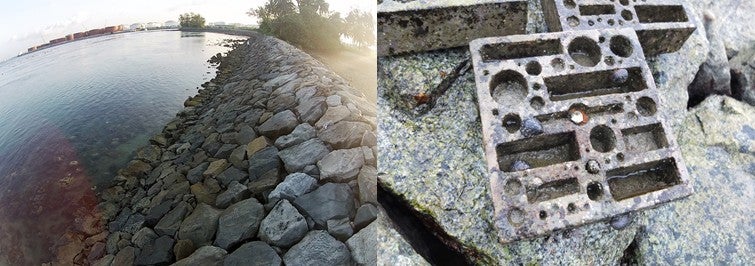Ecologically engineering Singapore’s seawalls
Peter TODD ((Group Leader, Biological Sciences) ) October 14, 201614 Oct 2016. NUS marine ecologists have developed structurally complex tiles with relevant microhabitats and a large-scale deployment strategy for enhancing intertidal biodiversity on seawalls in Singapore.
The combination of coastal urban development and climate change-associated threats has resulted in a rapid and worldwide increase in the construction of hard defences such as seawalls. These are generally designed with civil engineering goals and do not function as surrogates for the natural habitats they replace. Therefore, ecosystem services and resilience are lost. Despite these adverse consequences, only recently have researchers examined the ecological impacts of seawalls or suggested ways to boost biodiversity. As these structures are permanent, there is now greater interest in maximising their ecological value.
Prof Peter TODD and Dr Lynette LOKE, both from the Department of Biological Sciences at NUS who led this research work have shown that it is possible to increase biodiversity on coastal structures using concrete tiles moulded with complex designs. This work was mostly done as part of Dr Loke’s Ph.D. studies under the supervision of Prof Todd. Dr Loke developed a conceptual framework for informational complexity and, with Prof Todd, designed a computer programme for creating artificial substrates. Using these tools, they then fabricated, deployed and refined several concrete tile designs to identify the optimal microhabitat size range, complexity/variability and structure types that result in an overall increase in biodiversity. Dr Loke subsequently designed a novel experiment to find out how best to deploy these modular units. This enabled the team to determine the optimal density and spatial arrangement of retrofitting concrete tiles on seawalls in Singapore.
In highly urbanised Singapore, where seawalls constitute approximately 63% of the coastline, “hard” engineering mitigation options, such as increasing structural complexity, remain the most practical approach to enhancing seawall biodiversity. Integrating habitat requirements into engineering designs may offer opportunities to “improve” (i.e. restore functionality and enhance biodiversity) and extend coastal ecosystems while simultaneously achieving civil engineering goals.
The “problem” of low biodiversity on seawalls cannot be fully resolved without understanding why they support so few species. Globally, with the exception of work conducted at NUS, seawall ecology has only been studied in temperate regions. While we can learn from this research, studies in our tropical context are urgently needed.
In the next phase of their research, the team intends to better understand the ecological processes and mechanisms underpinning their results, using a combination of manipulative experiments and modelling approaches. As the construction of seawalls will inevitably continue, a clear understanding of their environmental, biological and ecological impacts is critical. This knowledge can be integrated into engineering practices at the design stage or during retrofitting, and will aid the enhancement and conservation of engineered shore biodiversity in an urban context by substituting concrete corridors with green ones. Ultimately, they envision that this will spur industry to incorporate complex topographical designs into new and existing coastal defence structures.

Figure shows (a) Aerial view of seawalls at Pulau Hantu, Singapore. (b) A close-up of an experimental unit used in performing large-scale field experiments. [Image credit: Lynette Loke]
For more details of their work, please see: https://sites.google.com/site/emelnus/home
References
Loke LHL, Todd PA. “Structural complexity and component type increase intertidal biodiversity independently of area.” Ecology. 97 (2016) 383-393.
Loke LHL, Liao L, Bouma TJ, Todd PA. “Succession of seawall algal communities on artificial substrates.” Raffles Bulletin of Zoology. 32 (2016) 1-10.
Loke LHL, Ladle RJ, Bouma TJ, Todd PA. “Creating complex habitats for restoration and reconciliation.” Ecological Engineering. 77 (2015) 307-313.
Loke LHL, Jachowski NR, Bouma TJ, Ladle RJ, Todd PA. “Complexity for artificial substrates (CASU): software for creating and visualising habitat complexity.” PLoS ONE (2014) e87990.


